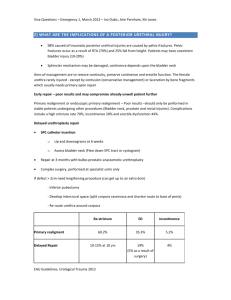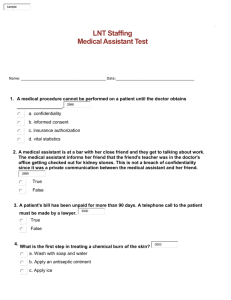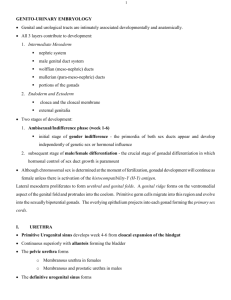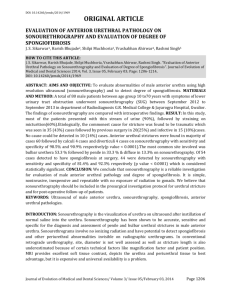Surgical technique - Centro Uretra Arezzo
advertisement
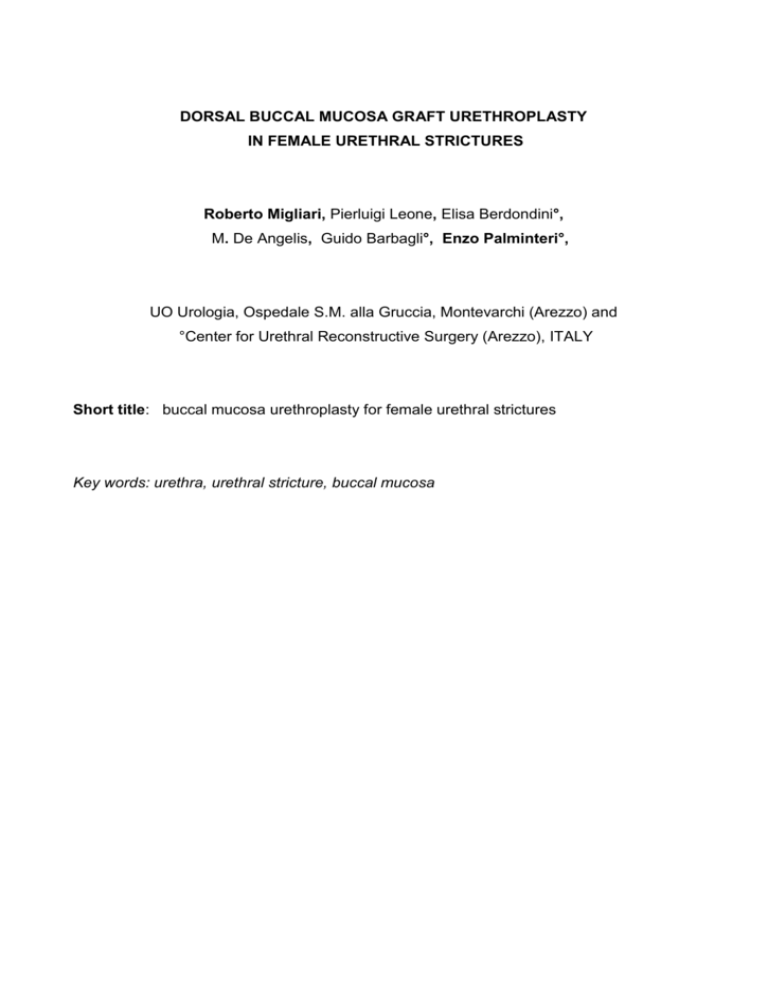
DORSAL BUCCAL MUCOSA GRAFT URETHROPLASTY IN FEMALE URETHRAL STRICTURES Roberto Migliari, Pierluigi Leone, Elisa Berdondini°, M. De Angelis, Guido Barbagli°, Enzo Palminteri°, UO Urologia, Ospedale S.M. alla Gruccia, Montevarchi (Arezzo) and °Center for Urethral Reconstructive Surgery (Arezzo), ITALY Short title: buccal mucosa urethroplasty for female urethral strictures Key words: urethra, urethral stricture, buccal mucosa PURPOSE We described the feasibility and complications of the dorsal buccal mucosa graft urethroplasty in female patients with urethral stenosis. MATERIALS AND METHODS From April 2005 to July 2005, 3 women 45 to 65 years old (average age 53,7) with urethral stricture disease underwent urethral reconstruction using dorsal buccal mucosa graft. Stricture etiology was unknown in 1 patient , ischemic in 1 and iatrogenic in 1. Buccal mucosa graft lenght ranged from 5 to 6 cm and width from 2 to 3 cm.. The urethra is freeded dorsally until the bladder neck, then it’s opened on the roof. The buccal mucosa patch is sutured to the margins of the opened urethra and the new roof of the augmented urethra is quilted to the clitoris corpora. RESULTS In all cases voiding urethrogram after cateter removal showed a good urethral shape with absence of urinary leaks. No urinary incontinence was evident post-operatively. At urodynamic investigation all patients showed an unobstructed Blaivas-Groutz nomogram Two patients complained about irritative voiding symptoms at catheter removal which subsided completely and spontaneously after a week CONCLUSIONS The dorsal approach with the use of buccal mucosa graft allowed to reconstruct an adequate urethra in the female reducing the risks of incontinence and fistula. INTRODUCTION Urethral strictures in women have long been debated with regards to their etiology and impact on voiding patterns(1-2) . Some authors suggest that most female urethral strictures are iatrogenic and, apart from radiation inducing urethral fibrosis, they may be the consequence of prolonged urethral catheterization or surgical repair of diverticulum, of fistula or are related to anti-incontinence procedures(3-7). Often, overzealous urethral dilatations with subsequent fibrosis due to bleeding and extravasation are among the most frequent causes of iatrogenic urethral strictures. The surgical treatment of these cases is still debated and varies from simple vaginal flap to pedicle labial skin tube urethroplasty wrapped with either labial fat or omentum depending from the complexity of the strictures (8-12). In male strictures the graft urethroplasty using a dorsal approach to the urethra has showed an improvement in urethral reconstruction due to reducing of fistulas and of graft weakening with urethral diverticula (15). The use of buccal mucosa graft (BMG) represents the goldstandard for urethral reconstruction in the male with complex hypospadias or urethral strictures ( aggiungere voce bibliografica). We suggest the technique of correction of urethral stricture in the female using BMG for urethroplasty with dorsal approach. MATERIALS AND METHODS From April 2005 to July 2005, 3 women 45 to 65 years old (average age 53,7) with urethral stricture disease underwent urethral reconstruction using dorsal BMG. Stricture etiology was unknown in 1 patient , ischemic in 1 (prolonged catheterization for reversal coma) and iatrogenic in 1 (diverticulum repair). All patients underwent multiple prior dilatations which failed before the surgical treatment and one patient had had a failure after previous urethroplasty sec. Frea . To evaluate stricture lenght all patients were evaluated preoperatively with cistourethrography. Urodynamic evaluation showed in all patients a stable bladder with low flow and low detrusor pressures; post void residual volume ranged from 90 ml to 200 ml. At clinical evaluation the urethral meatus was fibrotic while the urethra was rigid and stenotic. None of the patient complained about urinary stress incontinence. Surgical technique Under general anesthesia and with the patients placed in the dorsal lithotomy position a 10 Ch silicone urethral catheter is positioned. The BMG was harvested from the right inner cheeck. BMG lenght ranged from 5 to 6 cm and width from 2 to 3 cm.. All patients underwent free graft urethroplasty using the dorsal approach to urethral lumen. The dorsal part of the urethra is exposed by means of a U-reversed shape incision over the meatus (fig. 1) , starting from 3 to 9 o’clock hours. The vulvar mucosa is separated from the urethal channel and a plane is developed between the underlying urethra and the overlying cavernous tissue of clitoris (fig.2) to free the entire lenght of the urethra . The dissection is done taking care not to damage the bulbs and the crura of the clitoral body by staying close to the fibrous tissue of the urethra. During the dissection the anterior portion of the striated urethral sphincter is evidenced and move upward. A 5-0 stitch is placed on the dorsal surface of the urethra as close as possible to the bladder neck (identified by the catheter balloon), to mark it. An incision through the entire thickness of the dorsal urethra ( mucosa and spongiosal tissue) is done, from the meatus to the bladder neck. By means of a traction with 6 stitches on the edges o f the opened urethra, the ventral urethral plate is well exposed. Subsequently, the BMG is sutured to the right margin of the urethral plate and then to the left margin. The augmented dorsal urethra is quilted to the clitorid body to cover the new urethral roof. Distally the BMG is tailored and splitted in order to obtain a normal slit-like appearance of the meatus. Finally, the vulvar mucosa is reapproximated with 5-0 monocryl sutures. The patients were discharged after two days. After 15 days the catheter was removed and a voiding cistourethrography showed a normal appearance of the urethra. RESULTS In all cases voiding urethrogram after cateter removal showed a good urethral shape with absence of urinary leaks. At uroflowmetry a normal micturition was obtained and no urinary incontinence was evident. Two patients complained about irritative voiding symptoms at catheter removal which subsided completely and spontaneously after a week . At urodynamic investigation all patients showed a unobstructed Blaivas-Groutz nomogram. After six months the patients are well, residual urine is absent and the cosmetic results are very satisfactory. DISCUSSION Recently normal clitoral anatomy in healthy volunteers has been well displayed by MRI using fat saturation techniques without using any contrast agents; this study complements cadaveric studies of clitoral anatomy(16-17). The bright erectile tissue of the clitoris surrounds the urethrovaginal complex anterolaterally and provides strong dorsal a support to the urethra.. The bulbs of the clitoris on either side continue anterior to the urethra and meet together ventral to the urethra. Dissection studies have shown that they are not continuous across the midline. The exact role of the bulbs in urethral support and sexual function is not clear even if recent studies suggested they have a significant role in urthral continence. A concern about the dorsal approach to the urethra regards the possible lesion of the neurovascular bundles to the clitoris.The large clitoral neurovascular bundles ascend along the ischiopubic ramus to the under surface of the pubic symphysis in the midline, from which they run along the cephalad surface of the clitoral body towards the glans. Therefore they are quite far from the dissection area . Several histological studies as well as micro-dissections(17) of the femal urethra revealed that the female urethra has two thick muscular layers; an inner longitudinal layer and an outer oblique or circular layer. Both layers are direct continuations of the detrusor muscle. The urethral musculature is thickest close to the bladder and to the midurethra and diminishes as it is followed distally. Both the inner and outer layers end sharply in the distal fourth of the urethra by gaining insertion into dense collagenous tissue. From this level down to the external meatus the urethral wall is composed primarily of collagenous (tolta parola “tissue”) and elastic tissues . Another concern about the dorsal approach to the female urethra regards the possible lesion of the striated urogenital sphincter. This muscle in its upper two-thirds lies in a primarily circular orientation; distally it leaves the confines of the urethra and either encircles the vaginal wall as the urethrovaginal sphincter or extends along the inferior pubic ramus above the perineal membrane (urogenital diaphragm) as the compressor urethra. So the urethra in its upper ventral third is well separable from the adiacent vagina but its lower portion is fused with the wall of the latter structure. On the dorsal aspect the urethra is only juxtaposed to the clitoral structures which need to be carefully preserved during the dissection. The infrapubic approach to urethrolysis , either retropubic, infrapubic or vaginal has been advocated for the cure of voiding dysfunction following incontinence surgery with similar outcome. With this approache, emergent stress incontinence, even without resuspension,was indeed rare, thus confirming that the dorsal approach to the urethra does not cause an increased risk of urinary incontinence (18-20). In the recent past a dorsal approach to male urethral reconstruction has been proposed; the dorsal graft is mechanically supported by the corpora cavernosa and receives its vascular supply from the surrounding corpus spongiosum. This avoids the graft weakening with diverticula and reduces the risk of fistula (15). Similarly in the woman, the dorsal onlay graft urethroplasty offers a strong mechanical support , which allows it to fold on itself, reducing the opportunity of neovascularization and decreasing the caliber of the reconstructed urethra. Moreover, sacculation at the graft side , which might further compromise the state of the adjacent urethra facilitating recurrent stricture disease , is avoided. The graft apposition on the dorsal surface of the urethra led to a physiologic reconstruction of the urethra offering the possibility of modeling a urethral meatus which is directed up-ward. It leads to a more phisiological micturition as the urinary stream is directed upward and not toward the vagina. Another positive aspect of this urethroplasty is to keep intact the ventral part of the midurethra leaving the possibility of an anti-incontinence procedure on the mid-urethra. Despite requiring the use of optical magnification this procedure is easy to perform. In case of stenosis of the distal urethra or of the external meatus, as well as in case of longer urethral stenosis involving the mid-urethra , our dorsal onlay urethroplasty technique, especially when vaginal fibrosis limit the use of pedicled flap , offers a simple, safe and effective therapeutic alternative. The innovation of dorsal free graft repair may be tested on larger series and long term follow-up to evaluate if the use of free buccal mucosal graft for strictures of female urethra must be offered as a primary procedure and if it is anatomically healthier in the dorsal rather than in the ventral position. REFERENCES 1. Massey,J.A.,Abrams,P,H. Obstructed voiding in the female. Br.J.Urol.61:36,1988. 2. Mundy, A.R.: urethral substitution in women.Br.J.Urol. 63:80,1989 3. Ahmed,S., Neel,K.F. Urethral injury in girls with fractured pelvis following blunt abdominal trauma. Br.J.Urol. 78:450,1996 4. Hemal,A,K., Dorairajan,L.N., Gupta, N.P.: Post-traumatic complete and partial loss of the urethra with pelvic fracture in girls: an appraisal of management. J.Urol.163:282,2000 5. Lyon,R.P., Tanagho,E.A. Distal urethral stenosis in little girls. J.Urol. 93:379,1965 6. Brannan,D. Stricture of the female urethra. J. Urol. 66:242,1951 7. Roberts,M., Smith,P. Non-malignant obstruction of the female urethra.Br.J.Urol. 40:694,1968 8. Montorsi,F., Salonia,A.,Centemero,A.,Guazzoni,G.,Nava,L,Da Pozzo ,L.,Cestari, A., Colombo,R., Barbagli,G., Rigatti,P. Vestibular flap urethroplasty for strictures of the female uretra:Impact on symptoms and flow patterns. Urol.Int.,69:12,2002 9. Tanello,M., Frego,E., Simeone,C., Cosciali Cunico,S. Use of pedicle flap from the labia minora for the repair of female urethral strictures Urol.Int.69:95,2002 10. Falandry,L., Liang,X.L., Seydou,M., Alphonsi,r. Utilization of a pedicled labial flap,single or double face, for the management of post-obstetric urethral damage. J.Gynecol.Obste.Biol.Reprod. (Paris) 28:151,1999 11. Blaivas,J.G., Heritz,D.M., Vaginal flap reconstruction of the urethra and vesical neck in women. A report of 49 cases. J.Urol. 155:1014,1996 12. Frea,B., Maurel,A.,Kocjancic,E.,Milocani,M.L.,Meroni,T. Radical surgical treatment for female voiding disorders. Urodinamica,4:331,1994 13. Barbagli,G., Palminteri,E.,Guazzoni,G., Montorsi,F.,Turini,D. and Lazzeri,M bulbar urethroplasty using buccal mucosa grafts placet on the ventral ,dorsal or lateral surface of the urethra: are results affected by the surgical technque? J.Urol. 174:955,2005 14. Armenakas, N.A. Long-term outcome of ventral buccal mucosal grafts for anterior urethral strictures. AUA news,9:17,2004 15. Barbagli,G., Selli,C.,Tosto,A.,and Palminteri,E. Dorsal free graft urethroplasty. J.Urol.155:123,1996 16. O’Connell,H.E., De Lancey,J.O. nulliparous,healthy,premenopausal Clitoral volunteers using anatomy unenhanced in magnetic resonance imaging. J.Urol. 173:2060,2005 17. Baggish,M.S., Steele,A.C.,and Karram,M.M. The relationship of the vestibular bulb and corpora cavernosa to the female urethra: amicroanatomic study. Part 2 J.Gynecol Surg, 15:171,1999 18. Carr,L.K., and Webster,G.D. Voiding dysfunction following incontinence surgery:diagnosis and treatment with retropubic or vaginal urethrolysis. J.Urol., 157:821,1997 19. Nitti,W.V., and Raz,S:: Obstruction following anti-incontinence procedures: diagnosis and treatment with transvaginal urethrolysis. J.Urol.,152:93,1994 20. Virseda Chamorro, M., Teba del Pino,F.,Salinas,Casado, J.: Pressure flow studies in the diagnosis of micturition disorders in the 51:1021,1998 female. Arch.Espanoles Urol., LEGEND TO THE FIGURES Fig.1 U-reversed skin incision on the dorsal part of the urethral meatus from the 9 to the 3- o’clock position. Fig. 2 All the dorsal part of the urethra is dissected free from the surrounding tissue. Note the anterior part of the striated urethral sphincter ( arrow) Fig. 3 The dissected dorsal part of the urethra is incised longitudinally at the 12 –0’clock position from the bladder neck to the meatus Fig.4 The buccal mucosa graft is positioned on the dorsal part of the opened urethra Fig.5 the left side of the buccal mucosa graft is sutured to the epithelial margin of the opened urethra using 6/0 interrupted stitches with the knots inside the lumen Fig. 6 Final view of the reconstructed urethra before meatus modell

